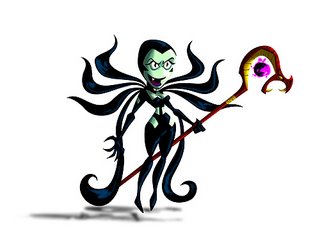PART II: Presenting Your WorkI don’t believe in art. I believe in artists.
-Marcel Duchamp
If you hear a voice within you say "you cannot paint," then by all means paint, and that voice will be silenced.
-Vincent Van GoghFamily. Religion. Friendship. These are the three demons you must slay if you wish to succeed in business. -C. Montgomery BurnsThis is the one I know you’ve all been waiting for. How do you put together a portfolio that will get you a job and where do you take it?
I’ve put together many a portfolio in my day, and more recently I’ve looked at dozens and dozens more. Your portfolio is probably the single most important asset you have when trying to get a job in TV animation. All of the good contacts you’ve made by raiding the Nickelodeon lunches and the good word from Uncle Pappy at Cartoon Network won’t mean squat if you don’t have a great portfolio to back it up. You’ll be competing with a huge number of other people, many of whom have a lot more experience than you do.
Two years ago while “The Grim Adventures of Billy and Mandy” was looking for a new character designer, Cartoon Network was swamped with portfolios from out-of-work Disney feature animators who’d been let go when Disney erroneously suspected that their crappy films were crappy because they weren’t CG. I sifted through a baker’s dozen large, leather-bound portfolios full of gorgeous life drawings that certainly surpassed anything I could do. These people had page after page of solid, well-crafted characters from some really great, classic Disney films that stretched back for decades. It turned out that I didn’t pick a single one of these amazing artists to fill the position, however. Instead, the job went to a 22 year old from New Jersey who happened to be out visiting friends and also happened to have a photocopy packet of his favorite drawings.
What
Phil did through an accident of good timing you can do by design, which is tailoring your portfolio to the studio and show you’re applying for. The Disney animators may have had loads of gorgeous animation drawings and life drawings, but "Billy and Mandy" is a weird, rubbery, surreal cartoon and we don’t actually animate anything here. That’s not to say that life drawing and animation aren’t vital skills to have in the TV animation industry. Far from it. But the person who’s looking at your portfolio isn’t going to care if you can render out a photorealistic elephant if you’re applying on “Dora the Explorer”.
This doesn’t mean that if you’re planning to apply for a job on “Chowder” that you should obsessively fill pages of your portfolio with drawing after drawing in “Chowder” style. A few drawings or pages of drawings will do. Just prove that you can draw the way that the show will require you to. And never use the actually characters from the show you’re applying for either. The contents of the portfolio should be your work, and until you’ve actually been paid to work on a particular series then you can’t claim that you’ve worked on it.
Basically, your portfolio says, “Hey, this is what I’ve done and it shows what I’m capable of.” If you put characters from “Dexter’s Lab” in your portfolio and you’ve never worked on “Dexter’s Lab”, several things will happen. And none of them are good. First, other studios around town will assume you have worked on “Dexter’s Lab”. While this could get you a job somewhere, eventually someone will out you and you’ll get a bad reputation. Second, if the creator of “Dexter’s Lab” were to get a hold of your portfolio, he could be very upset that you’re trying to pass yourself off as someone who’s worked on his show. At best, he’ll probably be super nit-picky with your drawings and tear them up worse than he would’ve if you’d just done
other characters in the style of “Dexter’s Lab”. So feel free to draw characters in the style of a show, but never use the actual characters from the show and never claim that you’ve worked on something you haven’t. Don’t pad the resume’. The resume’ doesn’t matter. What’s inside the portfolio is the only thing that counts.
So you’ve got a few pages of drawings that resemble the style of the show you’re applying for. What goes in the rest of the portfolio? What I look for is variety. I want to see that people are adaptable and can learn to draw in different ways. You don't have to be all over the map, just show a range. Maybe you do want a single page of life drawing in there. Just draw like you like to draw and fill a few pages with that. Then try to draw like you work for Klasky-Csupo. Then try something completely different. If I can see that a person can take the time to learn to draw in different ways, I believe that they can learn to draw like me and that makes me want to hire them.
You should not only have examples of different drawing styles, but also drawings of different things. If you like drawing bikini-clad ninjas or axe-murdering hermit crabs you should definitely have some of that in your portfolio to represent your interests. But have some other stuff in there to. Have backgrounds and landscapes and characters and props and animals and vehicles. When you drop off a portfolio, you’re often doing it blind to the jobs the company might have to offer. If you want the character design job but you’re willing to get a foot in the door doing prop design, that should be reflected in your portfolio.
Physically, your portfolio should be easily accessible. That means that a stapled pack of photocopies is preferable to a huge leather case full of gorgeous original drawings that I can’t get to because the zipper doesn’t work. I think it’s easy to have too many things in a portfolio. I can’t say what too long is, really, but I’ll say that you should keep the portfolio to just your very best work. Five pages or ten drawings is too small. Tease, but prove that you can put out. The portfolio is usually just a prelude to a test, so you’ll get a chance to really show them your stuff later.
Aesthetically, there’s always something to be said for an eye-catching cover. Don’t have everything in your portfolio totally cleaned-up and glossy. Have some rough stuff and quick sketches in there too. It’s good to see how people construct their drawings. If you’re a freak like
C.H. Greenblatt and drawings somehow just form from the tip of your pen… well, then you’re screwed.
Should you include your showreel or student film? If you’re planning to be a timer, director, or animator then a reel a few minutes long is vital. If you’re applying for anything else, it’s totally optional.
Don’t forget that humor is always a good thing. Have a gag drawing or a one panel funny cartoon. It’ll help your work be remembered later, even if you’re applying on an action show.
So, in short, have drawings in the style of the show you’re applying for, have drawings in a variety of other styles, draw many different kinds of things, have drawings representing other shows or projects you’ve worked on as well as things from your own imagination, and have something funny. Make sure your portfolio is easy to flip through, and eye-catching enough to invite the flipping to start. One thing my father taught me is that you should always put your best piece of work and your second best piece last. I find that works out for me pretty well.
There’s more TV animation now than ever, but nobody will call it an “animation boom” like they were when I moved out here. That’s because with layoffs in other areas of animation and the huge new crop of young animators coming in there are more people than there are jobs. When I’m looking at portfolios, it’s almost overwhelming. They don’t come in one at a time. They come in batches of five or seven every few days. Your portfolio is your foot in the door, so don’t underestimate the importance of making it a really pretty foot. After submitting your portfolio, let it sit for a week before calling to check on its whereabouts. Always have copies. I submitted a portfolio to a studio that lost it for two years. They found it and called me, but by the time I got over to the studio they’d lost it again.
If you get passed on, just take it in stride. Rework your portfolio and try again in a few months. There's a lot of competition for TV animation jobs right now, but the jobs by their nature are short-lived. It's not uncommon for a series to go on hiatus every nine months or so. Invariably, people leave and new people need to be hired.
Below is a list of studios and how to contact them. I’ll expand on it as I get the information on other studios. If you know any, feel free to chime in.
Cartoon Network Studios
300 North 3rd Street
Burbank, CA 91502
(818)729-4000
Portfolios at Cartoon Network are often passed through every show in the studio, insuring that you get some good exposure. And zealous Linda Barry makes sure that every portfolio gets seen. Adult Swim is based in Atlanta, and not part of Cartoon Network Studios in Burbank.
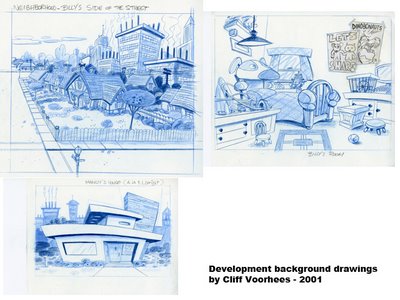
 Our opening title was done over the course of three days. Because that's how much people in TV animation care about quality. Thankfully, I had the help of editor Bobby Gibis and Flash mastermind Spencer Laudiero to help me through. The images above are marker comps and paintings by art director Rae McCarson.
Our opening title was done over the course of three days. Because that's how much people in TV animation care about quality. Thankfully, I had the help of editor Bobby Gibis and Flash mastermind Spencer Laudiero to help me through. The images above are marker comps and paintings by art director Rae McCarson.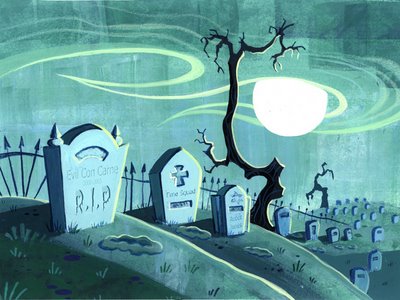 When we were doing the title, I knew I wanted a "dirty" look, but the film grain wiped out most of the detail. Here you can actually read the headstone gags...
When we were doing the title, I knew I wanted a "dirty" look, but the film grain wiped out most of the detail. Here you can actually read the headstone gags...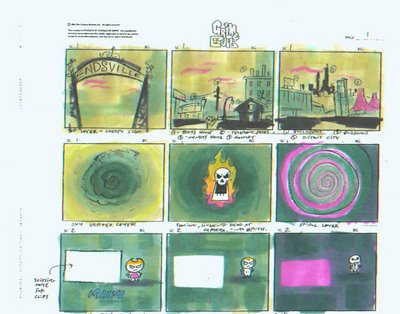 This is part of the rough storyboard I did for the titles.
This is part of the rough storyboard I did for the titles.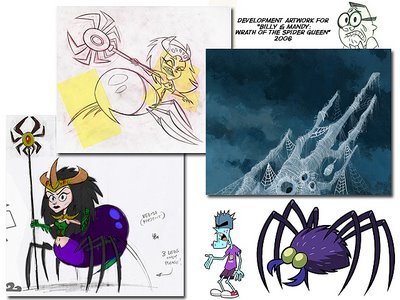 And here are some development drawings from Billy and Mandy's "final" episode. Make what you will of the quotes. The drawings above were done by Phil Rynda, Serapio Calm, and myself. The BG was painted by Don Watson.
And here are some development drawings from Billy and Mandy's "final" episode. Make what you will of the quotes. The drawings above were done by Phil Rynda, Serapio Calm, and myself. The BG was painted by Don Watson. Without giving much away, we learn a lot more about Grim's past. And we get to see some other characters from the show in a younger form. Above is Lord Pain. When we first saw him, he was obsessed with Grim. After that, he decided Mandy was his true Master. And who would Lord Pain be into before either of them?
Without giving much away, we learn a lot more about Grim's past. And we get to see some other characters from the show in a younger form. Above is Lord Pain. When we first saw him, he was obsessed with Grim. After that, he decided Mandy was his true Master. And who would Lord Pain be into before either of them?